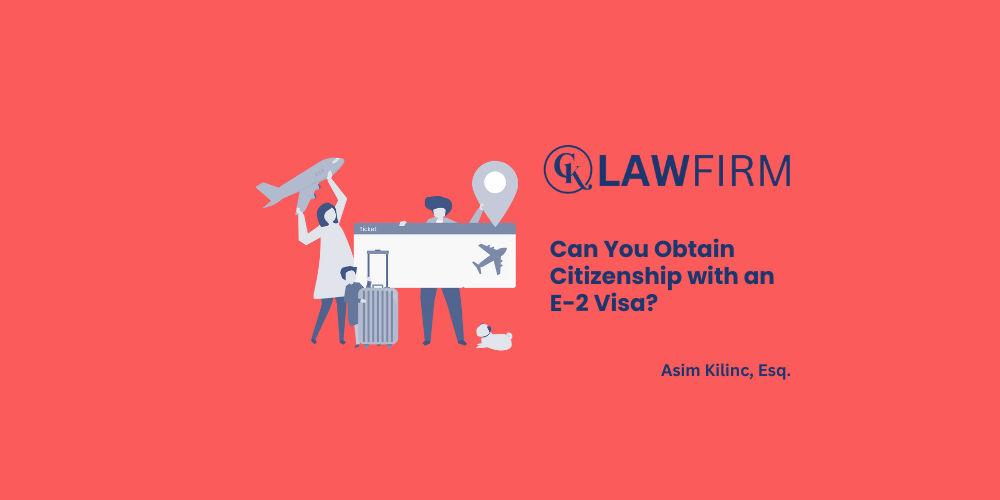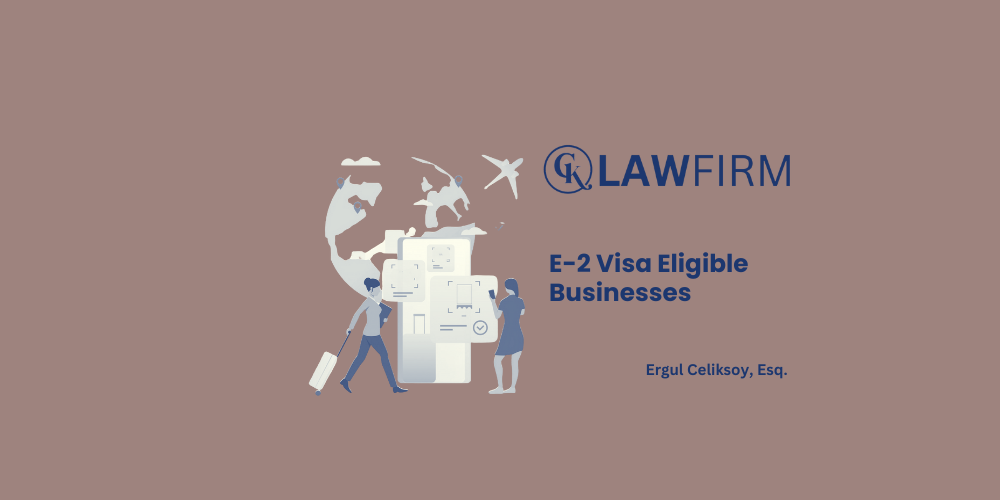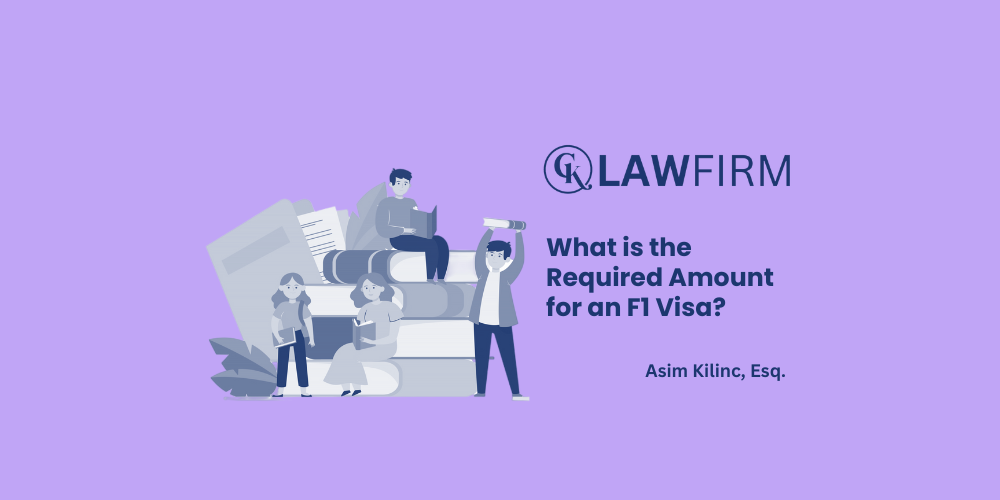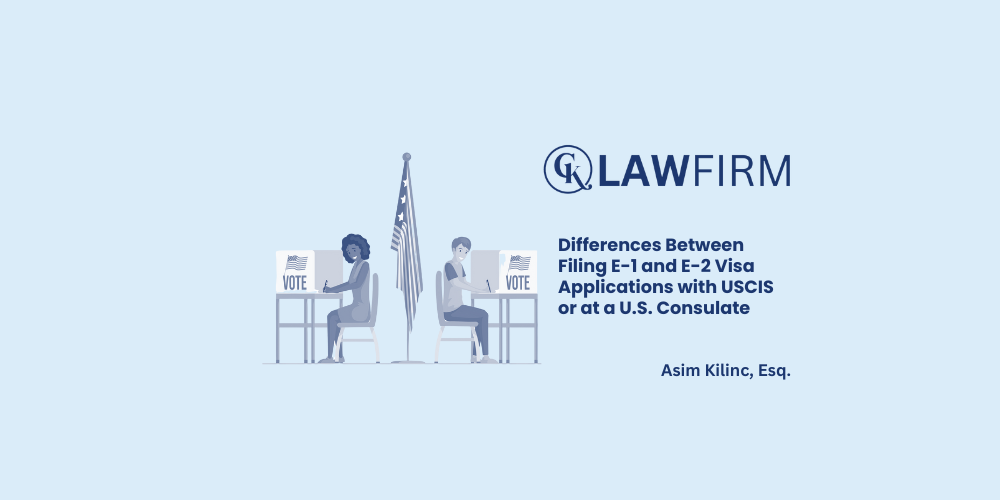Schedule an Appointment with Our Attorneys Now
By Asim Kilinc, Immigration Attorney at CK Law Firm
The E-2 visa is a popular option for individuals planning to invest in the United States, but it does not directly grant citizenship. The E-2 visa offers temporary immigrant status that can be renewed indefinitely under certain conditions, but additional steps must be taken to achieve U.S. citizenship. So, how can E-2 visa holders pursue citizenship? Here are the details on this topic.
- The Relationship Between the E-2 Visa and Direct Citizenship
- Potential Paths from an E-2 Visa to Citizenship
- Challenges of Obtaining Citizenship with an E-2 Visa
If you have any other questions about this topic, please don’t hesitate to reach out via the comments section below, send me a direct message on LinkedIn, or contact me through the website of CK Law Firm, where I am a co-founder!
The Relationship Between the E-2 Visa and Direct Citizenship
The E-2 visa is a temporary visa category designed for individuals planning to invest in the United States and includes the following features:
- Temporary Status: The E-2 visa allows an investor to live and work in the U.S., but this right is limited in duration. Most E-2 visas are granted for 2 to 5 years and can be renewed as long as specific requirements are met.
- No Green Card (Permanent Resident Status): The E-2 visa does not directly provide a pathway to a Green Card or citizenship. However, E-2 visa holders may consider alternative methods to achieve U.S. citizenship.
- Non-Immigrant Intent: Since the E-2 visa does not serve immigrant purposes, it is only valid during the investment activities in the U.S. Therefore, it does not directly offer a transition to permanent residency (Green Card).
Potential Paths from an E-2 Visa to Citizenship
E-2 visa holders may pursue U.S. citizenship through several strategies. Here are some of the available pathways:
1. Transitioning to a Green Card
While the E-2 visa does not directly grant a Green Card, investors can take steps to start this process:
- EB-5 Investor Visa: Individuals who can make a larger investment may qualify for the EB-5 visa, one of the most direct routes to obtaining a Green Card. The EB-5 visa typically requires an investment of $800,000 to $1,050,000.
- Marriage or Family Sponsorship: Marrying a U.S. citizen or receiving sponsorship through a Green Card-holding family member is another route to citizenship.
- Employment-Based Green Cards: Investors may apply for an employment-based Green Card through sponsorship within the sector they work in with the E-2 visa.
2. Transitioning from a Green Card to Citizenship
Once an E-2 visa holder obtains a Green Card, they can begin the citizenship process. Green Card holders are generally eligible to apply for citizenship after legally residing in the U.S. for five years.
Challenges of Obtaining Citizenship with an E-2 Visa
The transition from an E-2 visa to U.S. citizenship comes with certain challenges:
- No Direct Path: The E-2 visa does not provide a direct transition to a Green Card or citizenship, requiring investors to explore alternative options.
- Sustainability of Investment: To continuously renew the E-2 visa, the business in which the investment is made must remain active, profitable, and sustainable. This requires adapting to changing market conditions and careful business planning.
- Complexity of Alternative Routes: Other pathways to transition from an E-2 visa to a Green Card or citizenship (e.g., family sponsorship or employment-based applications) involve long and detailed processes, which can be challenging for investors.
Conclusion
The journey from an E-2 visa to a Green Card and U.S. citizenship can be complex. At CK Law Firm, we are committed to simplifying this process and providing tailored solutions for investors’ needs.
For more information about the E-2 visa and U.S. citizenship, feel free to reach out to us.
To receive professional support, detailed information, and consultation services, contact us at cklawfirm.org, via email at info@cklawfirm.org, or through LinkedIn.
Who is Attorney Asım Kılınç?
Attorney Asım Kılınç is the co-founder of CK Law Firm and is recognized for his expertise in immigration law and U.S. asylum applications. Kılınç completed his Master’s degree at Southern Methodist University Dedman School of Law and is a member of the Missouri Bar Association, with a focus on U.S. immigration law.
Attorney Kılınç’s extensive knowledge and experience in immigration law have significantly contributed to CK Law Firm’s success in this field. He has actively participated in the preparation of over 1,000 cases, demonstrating his expertise in this area. By providing comprehensive and professional legal support to his clients, he helps them adapt to their new lives in the U.S.
Attorney Kılınç is also well-versed in U.S. asylum applications. He meticulously guides his clients through the process and ensures they receive the best legal advice. He provides top-quality service to clients in matters of citizenship, Green Card, work permits, and other immigration processes, supporting them from start to finish on their journey to U.S. citizenship.
Attorney Asım Kılınç, who solidifies CK Law Firm’s leadership in immigration law and U.S. asylum applications, offers reliable and effective legal consultancy services to clients, assisting them in building a new life in the U.S.
By Ergul Celiksoy, Immigration Attorney at CK Law Firm
The E-2 visa is a special immigration status granted to foreign nationals who wish to invest in the United States under treaties of commerce and navigation between the U.S. and certain countries. However, eligibility for this visa depends not only on the size of the investment but also on the type of business and its contribution to the U.S. economy. So, which businesses qualify for the E-2 visa, and what should you consider during this process? In this article, we will cover the following points:
- General Characteristics of E-2 Visa Eligible Businesses
- Key Sectors for E-2 Visa Investments
- Importance of the Business Plan and the Application Process
If you have additional questions about this topic, feel free to leave a comment below, message me directly via LinkedIn, or contact me through the website of CK Law Firm, the immigration law firm I co-founded!
General Characteristics of E-2 Visa Eligible Businesses
Businesses eligible for the E-2 visa must meet specific criteria. The general characteristics of a qualifying business are:
- Economic Contribution: The business must contribute directly or indirectly to the U.S. economy. This can include creating new jobs or supporting economic growth.
- Non-Marginal Requirement: The investment must not merely provide the investor’s livelihood but also demonstrate a profitable business model.
- Sufficient Investment Amount: The investment amount should be proportionate to the business’s size and the requirements of the sector. For example, a small café might require a modest budget, while technology startups may need significantly higher capital.
- Operational Activity: The business must be active and operational. Passive investments, such as purchasing real estate alone, do not qualify for an E-2 visa.
Key Sectors for E-2 Visa Investments
Several sectors are popular among E-2 investors. Businesses in these industries tend to meet visa requirements and contribute significantly to the U.S. economy:
Restaurants and Food Services:
Restaurants, cafés, and other food-related businesses are popular choices among E-2 investors. Establishing a restaurant that caters to a demand for specific cuisines can lay a strong foundation for the visa application.
Retail Business:
Small-scale boutiques, grocery stores, and e-commerce platforms are suitable options due to their profitability and sustainability potential.
Technology and Software Startups:
Innovative technology startups are particularly advantageous for E-2 visas due to their high growth potential. A well-prepared business plan and sufficient capital are essential for this type of investment.
Service and Consultancy Firms:
Businesses offering consulting services, such as business management, education, or digital marketing, are also eligible for E-2 visa investments.
Hospitality and Tourism:
Hotels, motels, and other tourism-related businesses are commonly accepted for E-2 visas because of their job creation potential.
Importance of the Business Plan and the Application Process
The success of an E-2 visa application often depends on the strength of the business plan, in addition to the nature of the business. A detailed and convincing business plan is crucial for demonstrating the sustainability and profitability of the investment to immigration authorities.
Key Components of a Business Plan:
- The purpose and mission of the business
- Market analysis and industry research
- Business structure and organizational plan
- Projected revenues and expenses
- Employment opportunities created by the business
Another critical element is documenting the funding source. It is necessary to prove that the investment funds come from legal and personal resources.
Conclusion
The E-2 visa application process can be complex, requiring careful attention to detail. At CK Law Firm, our expert team ensures that investors navigate this process efficiently and successfully. From drafting business plans to compiling the necessary documentation, we provide professional support at every stage.
For professional assistance, detailed information, and consulting services, feel free to reach out to us via cklawfirm.org, info@cklawfirm.org, or LinkedIn.
Who is Attorney Ergül Çeliksoy?
Attorney Dr. Ergül Çeliksoy is a founding partner of CK Law Firm and also serves as an Assistant Professor of Law at the University of Nottingham. With extensive experience in U.S. immigration law, Dr. Çeliksoy completed a Master’s degree in international law and human rights law at the University of Nottingham in 2017, followed by a Ph.D. at the same university. His Ph.D., completed in 2022 at the University of Nottingham School of Law, marked a significant milestone in his academic career. Dr. Çeliksoy has published extensively in leading academic journals and is internationally recognized for his expertise in modern slavery, criminal justice, and criminal law. As a member of the California Bar, Dr. Çeliksoy offers exceptional service to his clients, particularly in U.S. immigration law cases. His expertise and experience in immigration law significantly contribute to CK Law Firm’s work in this area.
Dr. Çeliksoy provides comprehensive and strategic solutions to his clients in immigration law cases, helping secure their legal status in the U.S. His work on human rights and immigration processes, particularly in modern slavery and criminal law, effectively addresses the complex legal issues immigrants face. Dr. Çeliksoy reinforces CK Law Firm’s leadership in immigration law by offering reliable and effective legal consulting services to his clients, helping them build new lives in the United States.
By Asim Kilinc, Immigration Attorney at CK Law Firm
Studying in the United States is a dream for many students worldwide. However, to make this dream a reality, F1 visa applicants must meet specific financial requirements. In this article, I will explain in detail the financial amounts you need to consider when applying for an F1 visa, how these amounts are calculated, and what to pay attention to during the application process. You will find answers to the following questions:
- What is an F1 Visa?
- Why is Financial Adequacy Important for an F1 Visa?
- How is the Required Financial Amount for an F1 Visa Determined?
- Documents Needed to Prove Your Financial Adequacy
- What to Consider When Applying for an F1 Visa
If you have any questions about the F1 visa type that are not covered in this article, please feel free to reach out to me through the comments section below this post, via direct message on LinkedIn, or through the website of CK Law Firm, where I am a co-founder.
What is an F1 Visa?
The F1 visa is a non-immigrant visa issued to international students who wish to pursue full-time education in the United States. This visa allows you to study at accredited universities, colleges, language schools, and other academic institutions in the U.S. With an F1 visa, you can legally stay in the U.S. for the duration of your studies and work on-campus under certain conditions. However, to apply for this visa, you must demonstrate both academic and financial adequacy.
Why is Financial Adequacy Important for an F1 Visa?
The U.S. government wants to ensure that F1 visa applicants have sufficient financial resources to cover their education and living expenses. This requirement aims to prevent students from experiencing financial difficulties and having to abandon their studies after arriving in the U.S. Additionally, financial independence is crucial to avoid illegal work situations in the U.S.
How is the Required Financial Amount for an F1 Visa Determined?
The financial amount you need to provide when applying for an F1 visa depends on several factors. These factors include the type of school you will attend, the cost of living in the city where you will study, the duration of your studies, and your personal expenses. Generally, this amount consists of the following main categories:
- Tuition and Fees:
- Annual tuition fees at U.S. universities and colleges can vary widely. Private universities typically charge between $30,000 and $50,000 per year, while state universities may charge between $20,000 and $40,000. Additionally, graduate programs are usually more expensive than undergraduate programs.
- Annual tuition fees at U.S. universities and colleges can vary widely. Private universities typically charge between $30,000 and $50,000 per year, while state universities may charge between $20,000 and $40,000. Additionally, graduate programs are usually more expensive than undergraduate programs.
- Living Expenses:
- Living expenses can vary significantly depending on the city you will study in and your lifestyle. In expensive cities like New York, San Francisco, or Boston, living costs will be higher. You may need to budget between $1,500 and $2,500 per month for rent, food, transportation, and other essentials. In smaller, more affordable cities, this amount may range from $1,000 to $1,500 per month.
- Living expenses can vary significantly depending on the city you will study in and your lifestyle. In expensive cities like New York, San Francisco, or Boston, living costs will be higher. You may need to budget between $1,500 and $2,500 per month for rent, food, transportation, and other essentials. In smaller, more affordable cities, this amount may range from $1,000 to $1,500 per month.
- Health Insurance:
- Healthcare in the U.S. is quite expensive, and most schools require students to have health insurance. Annual health insurance costs can range from $2,000 to $4,000. This insurance will financially protect you in case of illnesses or accidents.
- Healthcare in the U.S. is quite expensive, and most schools require students to have health insurance. Annual health insurance costs can range from $2,000 to $4,000. This insurance will financially protect you in case of illnesses or accidents.
- Books and Supplies:
- Depending on the type of program you are enrolled in, you may need to spend between $1,000 and $2,000 annually on books and other educational materials. Costs may be higher in fields such as engineering or medicine.
- Depending on the type of program you are enrolled in, you may need to spend between $1,000 and $2,000 annually on books and other educational materials. Costs may be higher in fields such as engineering or medicine.
- Personal Expenses:
- Personal expenses include additional spending in your daily life, such as entertainment, clothing, travel, and other personal needs. It is advisable to set aside an annual budget of $2,000 to $3,000 for these expenses.
Documents Needed to Prove Your Financial Adequacy
When applying for an F1 visa, you must provide proof that you have sufficient financial resources to cover all the expenses mentioned above. These documents must be presented to the U.S. Consulate during your visa interview. Accepted documents include:
- Bank Statements: Bank statements in your name or your sponsor’s name must show that there is enough money in the account. These statements should generally cover the last 3 to 6 months.
- Scholarship or Grant Letters: If you have received a scholarship or grant, these documents can also be used to prove your financial adequacy. The documents should clearly state the amount of the scholarship and what expenses it covers.
- Sponsor Letters: If your family or another sponsor is providing financial support, you can submit an official letter from them stating the sponsorship amount and duration.
- Property Values and Investments: If you have assets or investments, you can provide documents showing their value. However, non-liquid assets are generally considered less valid.
What to Consider When Applying for an F1 Visa
Ensure that your financial documents are complete and accurate when applying for an F1 visa. Any missing or inconsistent information in your documents could result in your visa application being denied. Additionally, remember that your documents must be original and submitted in English.
Another important point is that you should demonstrate that you have enough funds not only for the first year of your visa but for your entire period of study. This is necessary to assure U.S. authorities that you will be financially independent throughout your education.
Conclusion
The amount required to prove financial adequacy for an F1 visa application can vary depending on various factors. You should ensure that you have sufficient financial resources to cover all your expenses during your studies in the U.S., including tuition, living costs, health insurance, and personal expenses. Submitting accurate and complete documents will greatly contribute to a positive outcome for your visa application.
It is crucial to prepare financially and carefully follow the entire process to turn your dream of studying in the U.S. into reality.
If you would like to find out whether you are eligible for an F1 visa, feel free to contact us at cklawfirm.org or reach out to me directly on LinkedIn for a free consultation. All you need to do is send us your CV!
Who is Lawyer Asım Kılınç?
Lawyer Asım Kılınç, as a founding partner of CK Law Firm, stands out with his mastery of both international law and the American legal system, gained through years of experience. Completing his Master’s degree at Southern Methodist University Dedman School of Law, Kılınç is registered with the Missouri Bar and specializes in U.S. immigration law. His deep knowledge and experience in immigration law have significantly contributed to CK Law Firm’s successes in this field. Having participated in the preparation processes of over 1,000 cases in immigration law, Lawyer Kılınç has proven his expertise in this field, providing comprehensive and professional legal support to his clients, facilitating their adaptation to their new lives in the U.S.
Strengthening CK Law Firm’s leadership in immigration law, Lawyer Kılınç offers reliable and effective legal consultancy services to his clients, standing by them in their journey to establish a new life in the U.S. He works to ensure that his clients receive the highest quality service in citizenship, Green Card, work permit, and other immigration processes, providing support to his clients throughout the entire process, from the beginning to U.S. citizenship.
By Ergul Celiksoy, Immigration Attorney at CK Law Firm
If you’ve ever dreamed of starting your own business in the United States, the E2 investor visa could be the key to turning your vision into reality. This visa allows entrepreneurs from treaty countries to establish or invest in a U.S.-based business and legally reside in the country. However, understanding the requirements, benefits, and process is crucial to making informed decisions and avoiding common pitfalls. In this blog, we’ll explore everything you need to know about the E2 visa and how it can help you achieve your business goals. In our article, I will touch on the following topics about the E2 investor visa:
- What Is an E2 Visa?
- Key Requirements for the E2 Visa
- Documents Needed for E2 Visa Applications
- Costs Associated with the E2 Visa
- Pathway to a Green Card
- Why the E2 Visa is Ideal for Entrepreneurs
With these headings, I will touch on the details about the E2 visa. For your questions about these issues, you can always contact us in the comments section of this blog or through our website. At the same time, if you want to contact me one-on-one, you can reach me via my LinkedIn account.
What Is an E2 Visa?
The E2 visa, also known as the E2 investor visa, is a non-immigrant visa for individuals from countries that have a treaty of commerce and navigation with the United States. This visa is designed for those who wish to make a “substantial investment” in a U.S. business. The investment must be significant enough to ensure the successful operation of the enterprise. Additionally, the applicant must have a controlling interest in the business, meaning they either own it outright or hold a majority stake.
The E2 visa for investors is available to nationals of eligible countries, which include a wide range of nations globally. Countries like Turkey, Japan, and Germany are part of this treaty agreement.
Benefits of the E2 Visa
- Fast Processing Times: Compared to other visa types, E2 visa processing is relatively quick, often completed within a few months.
- Inclusion of Family Members: Spouses and children under 21 can accompany the primary applicant. Spouses are also eligible to apply for work authorization.
- Renewable Status: The E2 visa can be renewed indefinitely, as long as the business remains operational and compliant with visa conditions.
- Opportunity to Live and Work in the U.S.: Entrepreneurs can actively manage their business while enjoying the benefits of living in the U.S., including access to top-tier education and healthcare for their families.
Key Requirements for the E2 Visa
Meeting the E2 visa requirements is essential for approval. Below are the main eligibility criteria:
- Citizenship of a Treaty Country: Only citizens of treaty countries are eligible for the E2 visa. Check the U.S. Department of State’s list of treaty countries to confirm your eligibility.
- Substantial Investment: The size of the investment is important for those who want to start a business with an E2 visa. Although US law does not set a specific lower limit, the investment is expected to be “large and meaningful”. For more detailed information, see “E2 Visa Investment Amount: How Much Should I Invest?” for more detailed information.
- Active Business Operations: The business must be active and operational. Passive investments, such as purchasing a rental property, do not qualify.
- Economic Contribution: The business should contribute to the U.S. economy, often demonstrated by creating jobs for U.S. workers or generating significant economic activity.
- Intent to Depart After Visa Expiry: As a non-immigrant visa, the E2 does not lead directly to a green card. Applicants must demonstrate their intention to leave the U.S. once their visa expires.
Documents Needed for E2 Visa Applications
A successful E2 visa application requires thorough preparation and documentation. Here are some of the key documents:
- Proof of Nationality: A valid passport from a treaty country.
- Investment Evidence: Bank statements, wire transfer receipts, or property purchase agreements proving the source and transfer of investment funds.
- Business Plan: A detailed plan showcasing your business’s objectives, financial projections, and market analysis.
- Operational Evidence: Documents such as leases, employee contracts, and supplier agreements.
- Personal Financial Records: Tax returns, asset declarations, and income statements to verify the legitimacy of your funds.
Costs Associated with the E2 Visa
The E2 visa cost includes various components:
- Application Fees: As of 2025, the visa application fee is approximately $205.
- Legal and Professional Fees: Attorney fees can range from $3,000 to $10,000, depending on the complexity of the case.
- Business Investment: The required investment amount varies by industry but should be sufficient to sustain the enterprise.
It’s essential to budget for all these expenses to ensure a smooth application process.
Pathway to a Green Card
While the E2 visa does not directly lead to a green card, some investors transition to permanent residency through other pathways, such as the EB-5 Immigrant Investor Program or family-sponsored petitions. Consulting an immigration attorney can help identify the best options based on your circumstances.
Why the E2 Visa is Ideal for Entrepreneurs
The E2 investor visa offers a unique opportunity to bring your entrepreneurial vision to life in the U.S. Whether you aim to launch a new business or expand an existing one, this visa provides the flexibility and support needed for success. With its renewable nature and family-friendly benefits, the E2 visa is a gateway to achieving professional and personal aspirations in America.
If you want to start a company or expand your existing business in the US, you can contact CK Law Firm through our Official Website to get detailed information about the E2 investor visa requirements. You can also contact me on my LinkedIn account for more information.

By Ergul Celiksoy, Immigration Attorney at CK Law Firm
How to Obtain a Green Card in the U.S. for Academics
For academics seeking permanent residency in the U.S., there are multiple Green Card options available. This guide outlines the primary programs academics can utilize to obtain a Green Card.
1. EB-1A: Extraordinary Ability
Academics with extraordinary abilities can apply for the EB-1A visa, designed for those with national or international acclaim in their field.
2. EB-1B: Outstanding Professors and Researchers
The EB-1B visa is suitable for professors and researchers with internationally recognized achievements, requiring at least three years of teaching or research experience.
3. EB-2 NIW: National Interest Waiver
Academics contributing to national interests can apply for the EB-2 NIW (National Interest Waiver), which does not require employer sponsorship.
4. EB-2: Advanced Degree Holders
Academics with a master’s or doctoral degree can apply for the EB-2 visa, which requires a job offer and employer sponsorship.
5. EB-3: Skilled Workers
Skilled individuals seeking academic positions may qualify for the EB-3 visa, which requires a specific job offer and employer sponsorship.
Application Process and Required Documents
The Green Card application requires evidence of academic achievements, reference letters, job offers, and complete forms as specified by USCIS.
Conclusion
There are several Green Card options for academics seeking permanent residency in the U.S. Determining the most suitable visa type and seeking professional advice is crucial. At CK Law Firm, we are here to guide you through the application process.
By Asim Kilinc, Immigration Attorney at CK Law Firm
For those seeking to travel to the United States for business or investment purposes, the most commonly used visa types are the E-1 (Trader Visa) and E-2 (Investor Visa). These visas provide temporary work and residency permits for individuals involved in trade with the U.S. or planning to invest in the U.S. However, choosing the correct institution for submitting E-1 and E-2 visa applications can significantly impact the application process and outcomes.
- Applying for E-1 and E-2 Visa through USCIS
- Applying for E-1 and E-2 Visas through the US Consulates
For additional questions, feel free to reach out through the comments section of this post, send me a message directly on LinkedIn, or contact me through the website of CK Law Firm, an Immigration Law firm I co-founded.
Filing E-1 and E-2 Visa Applications Through USCIS
USCIS (United States Citizenship and Immigration Services) is the federal agency responsible for handling immigration and non-immigrant visa applications within the U.S. Individuals already in the U.S. can file their E-1 or E-2 visa applications through USCIS.
Application Process Through USCIS
- Application Content: Applications through USCIS require thorough preparation. They must include detailed documentation about business plans, trade relationships, and investments.
- Types of Applications: USCIS accepts applications for change of status or extensions for individuals already in E-1 or E-2 status within the U.S.
- Results: USCIS does not issue visas but provides legal status to stay in the U.S. If the applicant leaves the U.S., they must obtain a visa from a U.S. Consulate to re-enter the country.
Advantages of Applying Through USCIS
- Suitable for Those Already in the U.S.: If the applicant is already in the U.S. and wishes to apply for an E-1 or E-2 visa, applying through USCIS is more convenient. Instead of applying for a visa, the applicant requests a change of status to E-1 or E-2.
- Ease of Status Extension: Individuals in E-1 or E-2 status can easily extend their status through USCIS without needing to leave the U.S. during the extension process.
Disadvantages of Applying Through USCIS
- Issues Upon Leaving the U.S.: Approval from USCIS grants legal status but not a visa. Upon leaving the U.S., the applicant must obtain a visa from a U.S. Consulate to re-enter the country.
- Longer Processing Times: USCIS applications may take longer to process compared to consulate applications. Depending on the case load, this could take several months.
Filing E-1 and E-2 Visa Applications Through U.S. Consulates
Applicants residing outside the U.S. can apply for E-1 or E-2 visas through a U.S. Consulate in their home country. Consulate applications are typically used by individuals who need a visa to enter the U.S.
Application Process Through Consulates
- Application Content: Consulate applications also require comprehensive documentation showing business activities, investment amounts, and trade relationships with the U.S.
- Visa Interview: Applicants must attend a visa interview at a U.S. Consulate. If the application is approved, the E-1 or E-2 visa will be added to their passport.
- Results: Upon approval, the applicant receives a visa that allows them to enter the U.S. and maintain E-1 or E-2 status.
Advantages of Applying Through U.S. Consulates
- Direct Visa Issuance: Consulate applications result in the issuance of a visa, making it easier to enter and exit the U.S.
- Faster Processing Times: Consulate applications are generally processed faster than USCIS applications. Depending on the consulate’s workload, processing can take just a few weeks.
Disadvantages of Applying Through U.S. Consulates
- Must Be Done Outside the U.S.: Applicants inside the U.S. who wish to apply through a consulate must leave the country, which can add time and cost.
- Interview Stress: Consulate applications require a visa interview, where the applicant must clearly demonstrate strong trade ties with the U.S. and their intent to return to their home country.
Comparison Between USCIS and Consulate Applications
| Criteria | USCIS Application | Consulate Application |
|---|---|---|
| Application Location | Within the U.S. | Outside the U.S. (U.S. Consulates) |
| Result | Legal status to stay in the U.S. | Visa issuance (entry and exit rights) |
| Interview | No interview required | Mandatory visa interview |
| Processing Time | Longer | Shorter |
| U.S. Entry | Must apply for a visa to re-enter | Direct entry with a visa |
| Application Fees | USCIS application fees | Consulate application fees |
Conclusion
E-1 and E-2 visas offer significant opportunities for individuals engaged in trade or investment with the U.S. However, the proper planning of the application process and choosing the correct submission method are critical to ensure visa approval. While USCIS applications are suitable for those already in the U.S., consulate applications provide a faster and more flexible solution.
For professional support and detailed information, feel free to contact us via our website at cklawfirm.org, by email at info@cklawfirm.org, or through LinkedIn.
Who is Attorney Asım Kılınç?
Attorney Asım Kılınç is the co-founder of CK Law Firm and is recognized for his expertise in immigration law and U.S. asylum applications. Kılınç completed his Master’s degree at Southern Methodist University Dedman School of Law and is a member of the Missouri Bar Association, with a focus on U.S. immigration law.
Attorney Kılınç’s extensive knowledge and experience in immigration law have significantly contributed to CK Law Firm’s success in this field. He has actively participated in the preparation of over 1,000 cases, demonstrating his expertise in this area. By providing comprehensive and professional legal support to his clients, he helps them adapt to their new lives in the U.S.
Attorney Kılınç is also well-versed in U.S. asylum applications. He meticulously guides his clients through the process and ensures they receive the best legal advice. He provides top-quality service to clients in matters of citizenship, Green Card, work permits, and other immigration processes, supporting them from start to finish on their journey to U.S. citizenship.
Attorney Asım Kılınç, who solidifies CK Law Firm’s leadership in immigration law and U.S. asylum applications, offers reliable and effective legal consultancy services to clients, assisting them in building a new life in the U.S.
Subscribe to Our Newsletter
Subscribe to our newsletter to stay informed about the latest announcements and articles written by our attorneys on U.S. immigration processes.
Aout Us
Our experienced lawyers at CK Law Firm offer effective solutions for those who want to make new beginnings in the USA. We facilitate and accelerate your immigration process by providing consultancy on all visa types.
Our Services
Visas
Business Green Card
Family Green Card
US Citizenship
Talent and Performance Visas
Work Visas
Investor and Trader Visas
Contact Us
+1 (972) 363- 96 89
info@cklawfirm.org
Address
2800 Regal Rd #102, Plano, TX 75075

All Rights Reserved by CK Law Firm.







